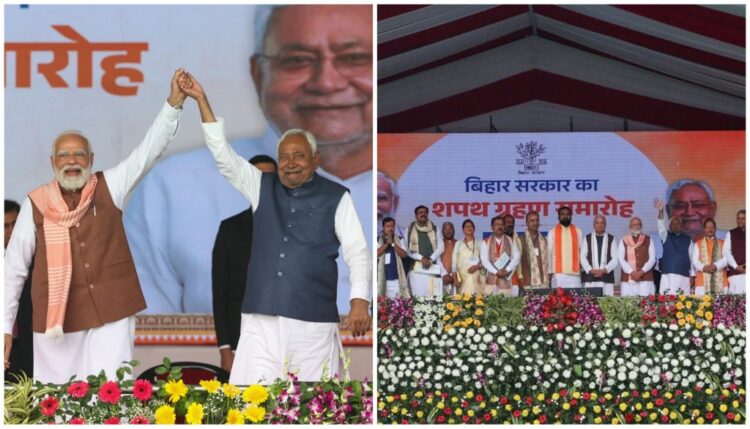Patna: Prime Minister Narendra Modi’s association with the Bihar gamchha has emerged as a significant image of this election cycle—transforming an aesthetic choice into a political messaging tool that has resonated from crowded rallies to the swearing-in of the new NDA government. At Gandhi Maidan, shortly after the new cabinet took office, Modi once again held the distinctive red-yellow gamchha high above the stage. The crowd responded with enthusiasm—chants of “Jai Bihar”, “Har Har Mahadev” and “Nitish Kumar zindabad” surged through the grounds. For many attendees, this act symbolized more than a mere gesture; it was a reaffirmation of their identity. The gamchha has journeyed from rallies to results to the oath stage.
This was not the first instance of this display. On November 14, following the NDA’s assured victory, Modi addressed the nation from Delhi, highlighting his speech by swinging the gamchha, expressing gratitude to the people of Bihar for their support. Previously, during a campaign rally in Begusarai and at the opening of a new bridge in the area, the PM’s public display of the gamchha elicited thunderous applause. Across various events, the reaction was consistent—enthusiastic crowds, raised fists, and spirited slogans. The significance of the gamchha in Bihar extends beyond being just a piece of cloth; it embodies workwear, identity, memory, and belonging—worn by laborers, farmers, elders, and youth alike.
Political analysts observe that when a leader wears or waves it, the message is clear: I acknowledge you, I am one of you, I honor your culture. Modi seems to grasp the emotional significance of this symbol. His team incorporated it into a strategy focused on cultural connection, transforming the gamchha into what one analyst termed “a shorthand for grassroots rapport”. At the oath ceremony, Modi’s gesture with the gamchha reinforced a meticulously crafted narrative of closeness to Bihar’s cultural identity. The visual transcended formalities, eliciting cheers from even the distant attendees in the expansive grounds. Political commentators argue that this “gamchha politics” now acts as an impactful communication tool—simple, local, relatable, and instantly recognizable.
NDA strategists reportedly view it as an effective framework for outreach beyond traditional political messaging. This fabric now carries significant political weight. Wednesday’s ceremony clearly emphasized that in Bihar today, the gamchha is not merely a garment—it represents a political language.
